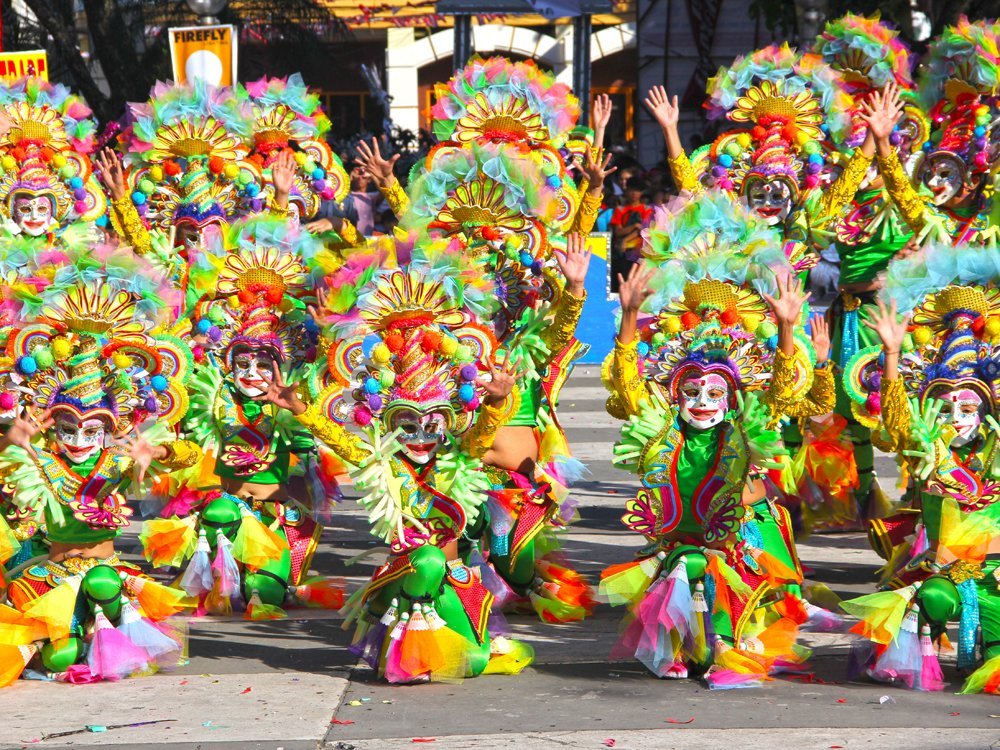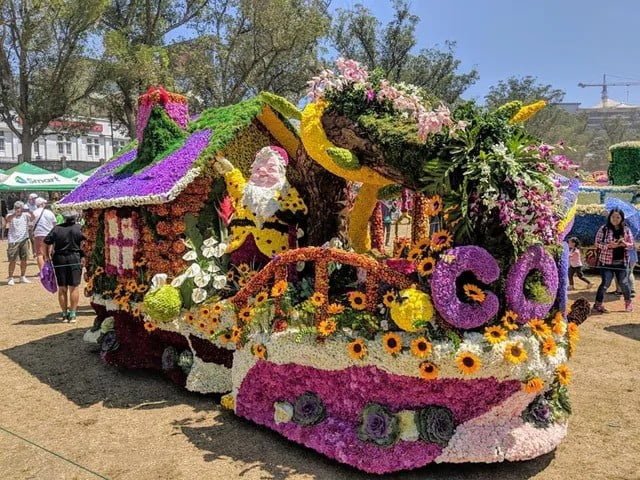The Dinagyang Festival is a vibrant cultural celebration that takes place in Iloilo City, Philippines. Renowned for its colorful parades, energetic dance performances, and elaborate costumes, the festival is a highlight of the region’s social calendar. It occurs every fourth Sunday of January, honoring the Santo Niño, or the Child Jesus, and celebrates the Christianization of natives as well as their revered patron saint. This festival has evolved from its simple beginnings to a grand and competitive spectacle that attracts visitors from all over the world.
At the heart of the festival are the tribe competitions, where different groups, known as “tribes,” perform dramatized dance routines that depict historical and cultural narratives. The performances are judged on choreography, performance, and the visual impact of their costumes and props. Beyond these competitions, the Dinagyang Festival is a showcase for Iloilo City’s rich history and culture, featuring religious ceremonies, street parties, and food festivals. It’s an occasion that brings together the traditional and the contemporary, reflecting the city’s spirit and its people’s ability to innovate while honoring their past.
Key Takeaways
- Dinagyang Festival is a significant cultural event in Iloilo City, marked by jubilant parades and dance competitions.
- It celebrates the city’s history and the Christianization of its people, merging religious observance with cultural festivity.
- The festival is a major attraction that has a profound impact on the cultural and economic vitality of Iloilo City.
Historical Context

The Dinagyang Festival is steeped in a rich history grounded in religious and cultural traditions. It is celebrated in Iloilo City, Philippines, and marks the acceptance of Christianity by the locals, intertwined with the reverence of the Santo Niño.
Origins of Dinagyang
The festival started in 1967 when a replica of the Santo Niño de Cebu was brought to the San Jose Parish of Iloilo City by the Philippine Missionary Society. This event was inspired by the Ati-Atihan festival of Aklan, which is also a tribute to the Santo Niño. The name “Dinagyang” was later coined in 1977, derived from the Hiligaynon word “dagyang” meaning “merry-making”.
Santo Niño de Cebu
The Santo Niño de Cebu holds significant influence in the Dinagyang Festival. Brought to the Philippines in 1521 by Portuguese explorer Ferdinand Magellan, the Santo Niño (Holy Child) symbolizes the Filipinos’ acceptance of Roman Catholicism. The devotion to the Santo Niño is widespread, with the statue housed in the Basilica Minore del Santo Niño in Cebu City. The Sinulog festival in Cebu, which is similar to Dinagyang, also celebrates the Santo Niño and echoes its importance in Philippine culture.
Cultural Significance
The Dinagyang Festival is not only a vibrant spectacle but also a profound representation of cultural and religious heritage. It pays tribute to history and spirituality through its colorful dances and elaborate costumes that reflect the traditions of the Ati Tribe and the veneration of the Santo Niño.
Tribal Representations
The Dinagyang Festival serves as a platform where historical roots and cultural narratives of the Ati Tribe are showcased. Participants, painted in dark tones and dressed in indigenous costumes, imitate the Ati people, the original inhabitants of Panay Island. These performances are meticulous re-enactments of tribal life, complete with traditional weapons, drums, and dances.
- Key Performances: Depicting scenes of trading, festivals, and daily life, these dances are a colorful retelling of the Ati Tribe’s rich history.
- Costume Significance: Each piece of attire signifies a part of the Ati culture, from the patterns representing folk stories to the headdresses denoting tribal status.
Religious Symbolism

The Dinagyang Festival is deeply intertwined with religious symbolism, primarily honoring the Santo Niño, the Child Jesus. The faithful express their devotion through elaborately choreographed dances and music that dominate the festivities, making it one of the Philippines’ most significant cultural and religious festivals.
- Santo Niño Procession: A pivotal moment where devotees carry the revered image through the streets as a gesture of faith and thanksgiving.
- Altars and Offerings: These highlighted features are not merely decorations but embody the people’s reverence for the divine.
Festival Events and Activities
The Dinagyang Festival in Iloilo City is renowned for its elaborate events and activities that transform the city into a vibrant hub of culture and festivity. Central to the celebrations, which peak on the fourth Sunday of January, are the Ati Tribe Competition and the expressive Street Dancing, accompanied by the resonating Dinagyang Pipes.
Ati Tribe Competition
Each year, competing tribes, adorned in elaborate costumes and body paint, vie for the crowd’s admiration and the judges’ approval in the Ati Tribe Competition. These tribes perform dramatized portrayals of indigenous culture, equipped with mobile risers – platforms on wheels that add a dynamic level to the performances. Their vigorous dances tell stories of tradition and the history of the Ilonggo people, and are judged for their choreography, props, and overall impact.
Dinagyang Pipes and Street Dancing
Magnified by the pulsating rhythms of the Dinagyang Pipes, Street Dancing is a highlight of the festival, flooding the streets with music and color. Dancers move in unison to the powerful beats, showcasing Iloilo’s rich cultural heritage. Each performance is a spectacle of movement, sound, and exuberance, reflecting the vitality and spirit of the Dinagyang Festival.
Modern Developments
The Dinagyang Festival has seen significant changes, particularly in the performances of Tribu Ilonganon and various Festival Innovations that have modernized the event while respecting its legacy.
Tribu Ilonganon
Tribu Ilonganon has become a hallmark of the Dinagyang Festival, showcasing the evolution of cultural performance. They have incorporated elaborate props and more sophisticated choreography to their performances, reflecting the growth of the festival. The City of Iloilo supports these advancements by providing better facilities and training to enhance the troupe’s capabilities.
- Performance Evolution: More complex dance routines.
- Support: Enhanced training programs.
Festival Innovations
Recent Festival Innovations aim to keep the Dinagyang experience fresh and exciting. The introduction of technology, such as drone displays and digital stage effects, has transformed the festival into a blend of tradition and modern spectacle. The City of Iloilo has embraced these innovations, ensuring that they add value while maintaining the essence of the Dinagyang legacy.
- Technological Advancement:
- Drone light shows
- Digital effects during performances
- City Involvement: Investment in technology to enrich the festival experience without overshadowing the traditions.
Impact on Iloilo City
The Dinagyang Festival significantly boosts Iloilo City’s economy and reinforces its cultural identity, attracting visitors from across the nation and showcasing its rich heritage.
Economic
Tourism Revenue: The influx of tourists during the Dinagyang Festival contributes substantially to the local economy. Hotels, restaurants, and local businesses experience a sharp increase in customers. In previous years, occupancy rates in hotels have spiked to nearly 100%, demonstrating the festival’s capacity to generate income for hospitality services.
Local Employment: The festival creates numerous temporary jobs, particularly in the service and retail sectors. These opportunities range from event staffing to souvenir production, helping to reduce unemployment in the city during the period.
Cultural Identity
Preservation of Heritage: Dinagyang offers Iloilo City a platform to preserve and promote its cultural heritage. Through vibrant performances depicting historical events, residents and visitors gain a deeper understanding of Iloilo’s past and its significance in the wider context of festivals in the Philippines.
Community Pride: The festival unifies the city’s residents in celebrating their collective history and traditions. It reinforces a sense of pride and strengthens community bonds, which is crucial for the social fabric of Iloilo.
Frequently Asked Questions
The FAQs below provide insight into the Dinagyang Festival’s historical significance, cultural highlights, scheduling, origins, latest winners, and its religious or secular dimensions.
What is the historical significance of the Dinagyang Festival?
The Dinagyang Festival commemorates the Santo Niño and the arrival of Malay settlers in Panay. It honors the Christianization of the natives by Spanish colonizers.
What are the main cultural highlights that the Dinagyang Festival is known for?
The festival is famously known for impassioned dance performances, vibrant costumes, and elaborate parades. A key highlight is the Ati-Atihan contest, featuring tribes competing in dance and music.
When is the Dinagyang Festival celebrated and what are the key dates for the 2024 festivities?
The Dinagyang Festival is annually celebrated on the fourth Sunday of January. In 2024, the key dates are from January 26th to January 28th, with main events typically occurring over the weekend.
What are the origins of the Dinagyang Festival and how did it evolve?
Originally, the festival began as a celebration of the Santo Niño in the 1960s. It has since evolved to include Aklanon culture, heritage, and history, transforming into a grand city-wide event with various spectacles and activities.
Who was declared the winner of the most recent Dinagyang Festival?
For the latest event, the champion of the Dinagyang Festival’s Ati-Atihan contest has not yet been publicly announced. The winner is typically honored for their outstanding performance, creativity, and representation of the festival’s themes.
Does the Dinagyang Festival have religious roots or is it a secular event?
The Dinagyang Festival has religious roots as it began in reverence to the Santo Niño. Over the years, it has incorporated secular elements but still retains its religious significance through church services and processions.



Pingback: Kaamulan Festival 2024 - Highlights and Events
Pingback: Where to Spend the Holy Week this 2024 - Roam Leisurely